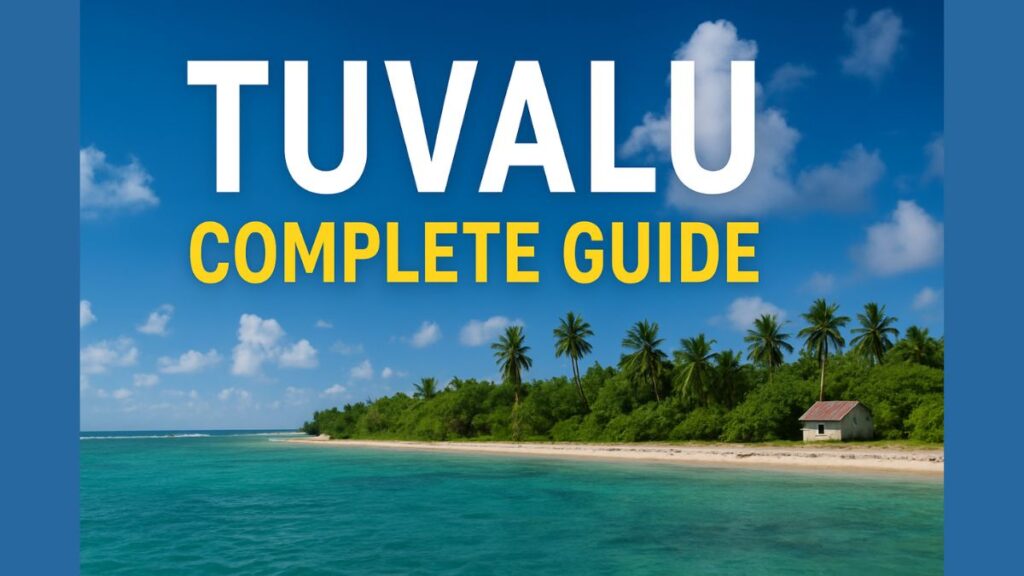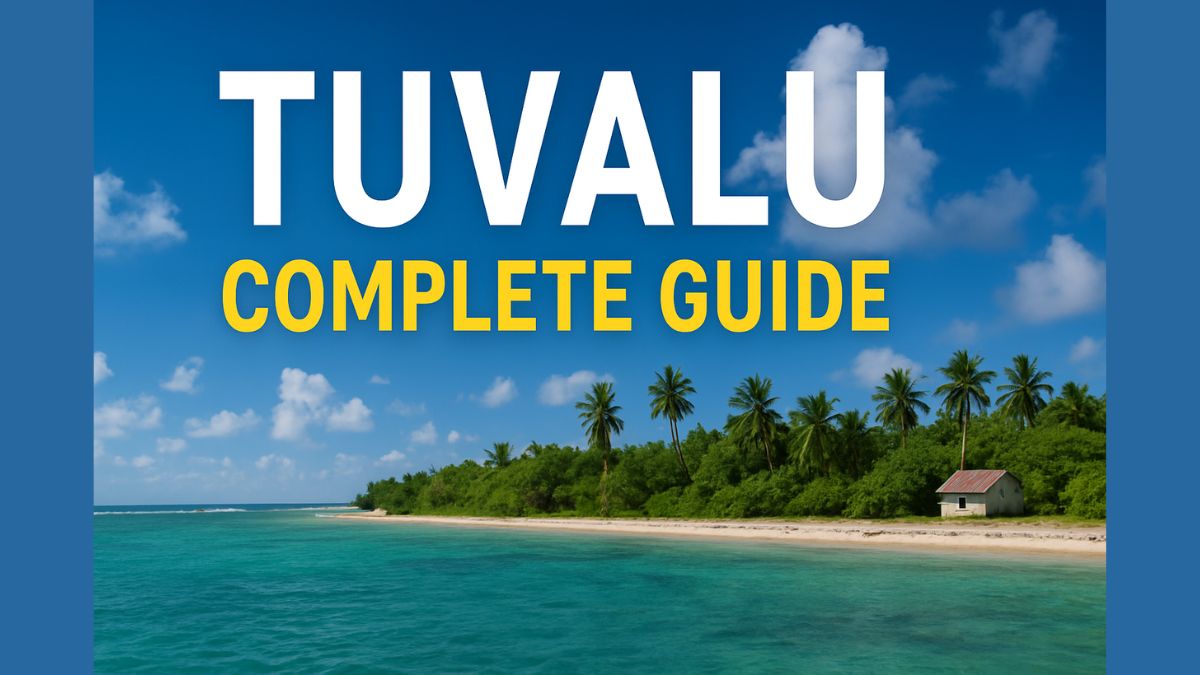Tuvalu – A Complete Guide to the Pacific’s Smallest Nation
Introduction to Tuvalu
Tuvalu is one of the smallest and most remote countries in the world. Located in the Pacific Ocean, this island nation covers only 26 square kilometers of land but stretches across an ocean area of about 900,000 square kilometers. With around 11,500 people, Tuvalu faces serious challenges such as rising sea levels, limited natural resources, and a heavy dependence on aid and remittances.
The country’s name means “eight standing together” in the Tuvaluan language, reflecting unity among its originally inhabited islands. Tuvalu became independent from Britain in 1978 and is now part of both the Commonwealth of Nations and the United Nations.
Geography of Tuvalu
Tuvalu lies between Hawaii and Australia in the Polynesian region of Oceania. The country is made up of three reef islands (Nanumanga, Niutao, Niulakita) and six atolls (Funafuti, Nanumea, Nui, Nukufetau, Nukulaelae, Vaitupu).
Funafuti, the capital, is also the largest atoll. It has a lagoon measuring 25 kilometers north to south and 18 kilometers east to west. The islands are narrow, flat, and very low-lying, with the highest point only 4.6 meters above sea level.
Because of this, Tuvalu is extremely vulnerable to cyclones, storm surges, and flooding. The tropical climate has two main seasons:
- Wet season (November to April): Heavy rain and westerly winds
- Dry season (May to October): Moderate easterly winds
Temperatures stay between 28°C and 30°C. Weather is affected by El Niño and La Niña patterns, which bring droughts, cyclones, or increased rainfall.
Natural resources are scarce. The country depends on fish, coconuts, and rainwater collection. The Funafuti Conservation Area protects 33 square kilometers of reefs and lagoons. Environmental issues include saltwater intrusion, waste disposal problems, and coral reef damage.
Key Geographical Facts about Tuvalu
| Feature | Details |
|---|---|
| Land Area | 26 km² (10 sq mi) |
| Exclusive Economic Zone | ~900,000 km² |
| Coastline | 24 km |
| Highest Elevation | 4.6 m (Niulakita) |
| Average Rainfall | ~3,000 mm annually |
| Main Hazards | Cyclones, king tides, sea level rise |
History of Tuvalu
Early Settlement
People arrived in Tuvalu about 3,000 years ago from Samoa and Tonga using canoes and advanced navigation skills. Life was based on fishing, farming crops like pulaka and taro, and living in close-knit communities led by chiefs and elders. Oral traditions link some islands to Samoa and others to Tonga.
European Contact and Colonization
The first European sighting was in 1568 by Spanish explorer Álvaro de Mendaña. In 1819, Funafuti was named “Ellice’s Island,” later becoming part of the Gilbert and Ellice Islands Colony under British control in 1916.
Christian missionaries arrived in the 19th century, bringing major social changes. During World War II, U.S. troops built airfields on some islands, bringing new infrastructure but also displacing villagers.
Independence and Recent Changes
In 1974, a referendum allowed Tuvalu (then called the Ellice Islands) to separate from the Gilbert Islands. Tuvalu became fully independent on October 1, 1978.
Since independence, Tuvalu has been active in global discussions about climate change. In 2022, the government announced a digital twin of Tuvalu in the metaverse to preserve its culture and identity in case rising seas threaten its land.
In 2023, Tuvalu signed the Falepili Union treaty with Australia, which offers migration options for Tuvaluans and financial support for coastal protection. In 2024, Feleti Teo became Prime Minister after a general election. Tuvalu continues to maintain close ties with Taiwan, rejecting Chinese diplomatic pressure.
Historical Timeline of Tuvalu
| Year | Event |
|---|---|
| ~1000 BCE | Polynesian settlement begins |
| 1568 | First European sighting |
| 1892 | British protectorate established |
| 1942–45 | U.S. military presence during WWII |
| 1974 | Referendum to separate from Gilberts |
| 1978 | Independence from Britain |
| 2000 | UN membership |
| 2022 | Digital replica project announced |
| 2023 | Falepili Union treaty with Australia |
| 2024 | Feleti Teo elected Prime Minister |
Political System of Tuvalu
Tuvalu is a parliamentary democracy under a constitutional monarchy. The British monarch is the head of state, represented locally by a Governor-General. The Parliament of Tuvalu (Palamene o Tuvalu) has 16 elected members, but there are no formal political parties. Candidates run as independents, and alliances are formed after elections.
The Prime Minister, chosen by Parliament, leads the government. Each island also has a local council known as falekaupule, combining traditional leadership with modern administration.
Foreign relations are focused on climate diplomacy and partnerships with Australia, New Zealand, Taiwan, and the U.S. Tuvalu is also a member of the Pacific Islands Forum, IMF, and UN.
There is no military; defense comes from agreements with friendly nations. A small police force handles internal security. Tuvalu is considered politically free, though it faces policy challenges related to climate migration and limited media options.
Economy of Tuvalu
Tuvalu has one of the smallest economies in the world. Its GDP is around $60 million (2023 estimate). The main sources of income are:
- Fishing licenses issued for tuna fishing in Tuvalu’s EEZ (about $50 million per year)
- Foreign aid from Australia, New Zealand, Japan, and the EU
- Remittances from Tuvaluans working abroad (10–15% of GDP)
- .tv internet domain lease, earning $5 million annually
Agriculture is mostly subsistence farming, with coconuts, pulaka, and taro grown for local use. Tourism is minimal due to isolation and lack of infrastructure.
The Tuvalu Trust Fund, established in 1987, supports government finances and helps stabilize the budget. In 2025, Starlink internet services improved telemedicine in remote islands. The IMF recommends expanding eco-tourism and sustainable fishing to diversify income.
Economic Data for Tuvalu (2023–2025)
| Indicator | Details |
|---|---|
| GDP | ~$60 million |
| GDP per capita | ~$5,000 |
| Growth Rate | 3–4% |
| Main Revenue | Fishing, aid, remittances |
| Unemployment | ~2% (underemployment higher) |
| Inflation | 3–5% |
| Key Partners | Australia, Fiji, Japan |
People and Demographics
Tuvalu’s population is about 11,500 people. Over 60% live on Funafuti, which is becoming crowded as people move there for jobs and services.
Most people are Polynesian (96%), with a small Micronesian minority. The official languages are Tuvaluan and English, and almost everyone is bilingual.
Christianity is dominant, especially the Church of Tuvalu (Congregationalist), which has about 91% of followers. Literacy is very high at 99%, and education is free until age 15.
Life expectancy is 62 years for men and 67 for women. Non-communicable diseases such as diabetes and obesity are rising problems. Many Tuvaluans are applying to migrate under Australia’s climate visa program, with over 4,000 applications by 2025.
Population Statistics
| Feature | Value |
|---|---|
| Total Population | 11,500 |
| Urban Population | 64% (mostly Funafuti) |
| Literacy Rate | 99% |
| Main Religion | Christianity (97%) |
| Median Age | 26 years |
| Growth Rate | 1.1% |
Tuvaluan Culture
Tuvalu’s culture is strongly community-oriented, based on family ties and respect for elders. Traditional music and dance are central to celebrations. The most popular dance form is fatele, performed in groups with drums and guitars.
Sports such as kilikiti (a local form of cricket), soccer, and volleyball are widely played, and Tuvalu participates in the Pacific Games.
Tuvaluan food is simple and uses local ingredients such as fish, coconuts, pulaka, and taro. A well-known dish is palusami, made with taro leaves and coconut cream. Handicrafts like mats and baskets woven from pandanus leaves are still practiced.
Independence Day and religious holidays are major events. Oral storytelling continues to preserve history, and efforts are being made to digitize cultural heritage to prevent its loss as people migrate abroad.
Environment and Current Issues
Tuvalu is often described as being “on the frontline of climate change.” Most of the country lies less than 2 meters above sea level, which makes it extremely vulnerable to rising seas. By 2050, large parts of Tuvalu may become uninhabitable if global warming is not controlled.
Main environmental challenges:
- Coastal erosion and flooding during high tides
- Saltwater entering farmland and drinking water supplies
- Coral reef damage and overfishing
- Stronger and more frequent cyclones
To respond, Tuvalu is building seawalls, elevating land, and using international support through programs like the Tuvalu Coastal Adaptation Project funded by the UN. Early warning systems for disasters were introduced in 2025.
The Falepili Union treaty with Australia gives Tuvaluans a safe migration pathway while supporting climate projects. Tuvalu also speaks strongly at global climate meetings, asking major countries to cut fossil fuel use.
In recent years, Starlink satellite internet has improved communications, helping schools and health clinics in remote areas. Despite these developments, Tuvalu continues to face the risk of losing its land and culture, making international cooperation vital.

Frequently Asked Questions about Tuvalu
1. Where is Tuvalu located?
Tuvalu is in the central Pacific Ocean, between Hawaii and Australia, in the Polynesian region of Oceania.
2. What is Tuvalu known for?
It is known for being one of the smallest and lowest-lying countries, its “.tv” internet domain, and its role in global climate change discussions.
3. Does Tuvalu have an airport?
Yes, Funafuti International Airport serves the country, with limited flights mainly to Fiji.
4. What currency does Tuvalu use?
The Australian dollar (AUD) is the official currency, though Tuvalu also issues its own coins.
5. What language do people speak in Tuvalu?
Tuvaluan and English are both official languages, and most people speak both.
Tuvalu may be small, but it carries a powerful voice in global issues. Its people, culture, and history show resilience in the face of challenges like climate change, limited resources, and economic dependence. With international support, new technology, and cultural preservation efforts, Tuvalu continues to fight for its survival and identity.
To check other Articles, Click Here.

“I’m a travel enthusiast who loves exploring new places and sharing stories from my adventures. Through this website, I share simple tips, hidden gems, and ideas to make your trips more enjoyable. Whether it’s beaches, mountains, or local food, I enjoy discovering and writing about it all. When I’m not traveling, I’m planning my next trip or helping others explore new destinations. Let’s discover the joy of travel together!”





